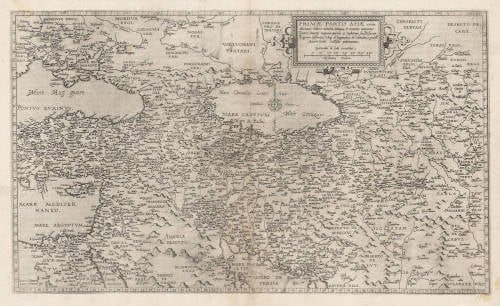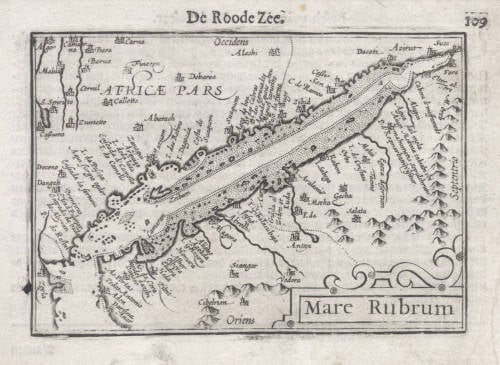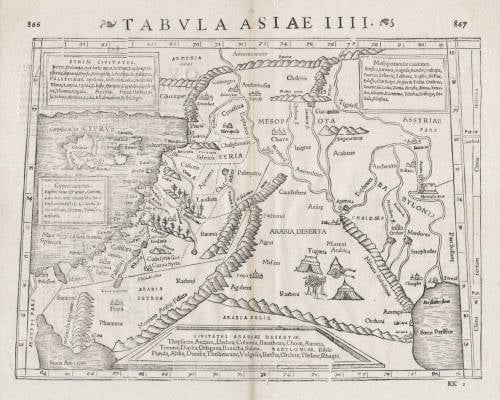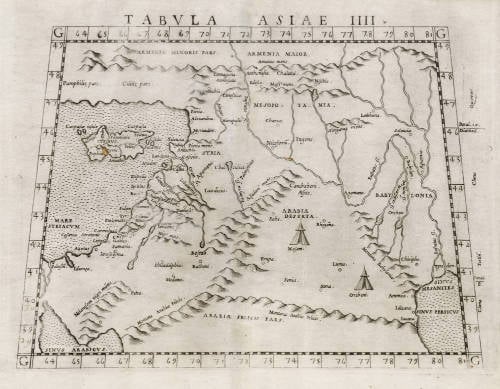Leen Helmink Antique Maps
Antique map of Cairo by Sebastian Münster
Stock number: 19313
Zoom ImageCartographer(s)
Sebastian Münster (biography)
Title
Warhafftige Abcontrafehtung der mechtigen vnd vesten Statt Alkair.
First Published
Basle, 1575
This Edition
1592 German
Technique
Condition
excellent
Price
$ 1,250.00
(Convert price to other currencies)
Description
One of the first obtainable depictions of the legendary city of Cairo, with many landmarks named.
North is on the left, with the Nile delta estuary in the lower left, with lots of crocodiles. The pyramids are on the right of this bird eye's view, with the Great Sphinx of Giza below it.
On the back is a depiction of Queen Cleopatra, the last pharaoh of Egypt before it was taken over by the Roman Empire. She is holding the snake that would end her life.
Munster's view of Cairo is relatively scarce because it only appears in the later editions of the Cosmographia, from 1575 onwards.
Munster's city views are of high significance because they were much more widespread than the Braun and Hogenberg views.
Munster's Cosmographia sold in huge quantities all over Europe, because it was far more affordable than folio atlases. More than 42 editions of the Cosmographia were published between 1550 and 1628, in five languages.
Another reason for its success was the fact that the Cosmographia was not just an atlas, it was more like an encyclopedia with vast amounts of knowledge about the history of the world, about religion, about all imaginable sciences (mining, medical, masonry, chemistry, distillation), and about European and overseas cultures and etnography. As well as about voyages of discovery and the geography of the world.
Condition
Good offprint from the woodblock, from the 1592 German edition. Excellent condition. In original colour, which is unobtainable for Munster woodcuts, the kind of item that is lacking in every collection. A very desirable collector's item.
Title
"Warhafftige Abcontrafehtung der mechtigen vnd vesten Statt Alkair."
True depiction of the mighty and strong city of Cairo.
Introductory text on verso
"Die Statt Alcair, auff Arabisch Mazar/Chaldeisch Alchabir/Hebraisch Defraim/ vnd zu Latein Babylon genannt/contrafehret. Diese soll fünffmal grósser seyn dann Pariß in Franckreich/darzu vberauß Volckreich. Wenig Leut sind da/welche (wie bey vns breuchig) eynkauffen/ihr Speiß vnd Kost daheim rüsten/sonder wann sie essen wollen/nemmen sie es bey den Köchen vnd Brätern/deren ob dreissig tausent darinn zu finden. Sie hat mechtige Vorstett/deren etliche drey tausent/etliche zwölff taussent Heuser haben."
The city of Cairo, in Arabic called Mazar, in Chaldean Alchabir, in Hebrew Defraim, and in Latin named Babylon, depicted. This city is said to be five times larger than Paris in France and is exceedingly populous. There are few people there who, as is customary among us, shop for their food and prepare their meals at home; instead, when they want to eat, they get it from the cooks and roasters, of whom there are more than thirty thousand in the city. It has mighty suburbs, some of which have three thousand houses, while others have twelve thousand houses.
Descriptive text below and on verso of the map
"Mören Landt. Darnach da Cyrus von Persia vnderwarff Mediam vnd Assyriam/vnd das grösser theil des vordern Asie/vberwand er auch den hoffertigen König Sesostrem/ vnnd erobert das Reich von Egypten. Aber alß nachmals Darius Nothus die Monarechen in Asia verlot/wurffen die Egyptier widerumb auff ein König/vnd waren im vndersthenig/biß zu den zeiten des Groffen Alexandri/das nun vngefehrlich bey vierhundert jar vor Christi geburt ist gewesen. Da aber der Groß Alexander starb/ vnnd die Fürsten seines Hofs vnder sich theilten die eroberte Monarchen/ward dem Sohn Lagi/mit namen Ptolemeo/zu theil Egyptenlandt/vnd blieb auch diß Königreich vnder den Ptolemeis bey 295 jar/biß zur Königin Cleopatra/die fich ertödt mit Schlangen gifft/ da sie ihrer Tyranenn halb in gefehrlichkeit des todts war. Nach ir besassen die Römer Egyptenlandt/vñ feßten ein Landtvogt dareyn/machten auß dem Königreich ein Provinz/vnd behielten es auch biß zu dem jar Christi 619. da fielen vnder dem Keyser Heracleo die Saracenen dareyn/vnd namen es eyn/ sezten König dareyn/die nennten sie Sultanen/das sind Gewalthaber: dan ** Sultan in Hebraischer/Chaldaischer vnd Arabischer Spraach heißt ein Gewaltigen/darvon in vnser Teutsche Sprach auch kommen ist das Wort Schultheiß. Also habe die Mahometischen oder Saracenen behalten das Landt ein lange zeit biß zu den jar Christi 1517. oder vmb dieselbige zeit/da hat den Türck den Sultan darauß vertrungen/vnd das Landt vnder seine Geswalt genommen/wie ich das hievorně bey dem Türckischen Keyser Zelymo gnugsamlich beschrieben hab. Der Stett halb des Egyptischen Landts soltu mercken/daß es vorzeiten also wol erbawen ist gewesen/daß man darin gezehlt hat 18000. Stett vnd namehafftiger Fläcken/vnder welche doch die fürnemesten sind gewesen/Memphis/Eliopolis/Pelusium/Tanais vnd Alexandria/wiewol Alexandria lang nach den andern erbawen ist."
Land of the Moors. After Cyrus of Persia subdued Media and Assyria, and the larger part of western Asia, he also defeated the haughty King Sesostrem and conquered the kingdom of Egypt. However, when later Darius Nothus lost the monarchies in Asia, the Egyptians again chose a king and were subject to him until the times of the Great Alexander, then roughly four hundred years before the birth of Christ. But when the Great Alexander died, and the princes of his court divided the conquered monarchies among themselves, the son of Lagus, named Ptolemy, was given the land of Egypt, and this kingdom remained under the Ptolemies for about 295 years until Queen Cleopatra, who poisoned herself with snake venom when she was in danger of death because of her tyrants. After her, the Romans possessed the land of Egypt and installed a governor there, transforming the kingdom into a province, and they retained it until the year of Christ 619. During the reign of Emperor Heraclius, the Saracens invaded and took possession of it, setting up kings whom they called Sultans, which means "Rulers." For the word "Sultan" in Hebrew, Chaldean, and Arabic means "the Mighty." From this, in our German language, also came the word "Schultheiß" (sheriff or magistrate). The Mohammedans or Saracens held the land for a long time until around the year of Christ 1517. At that time, the Turk drove out the Sultan and took control of the land, as I have previously described in detail concerning the Turkish Emperor Selim. Regarding the cities of the Egyptian land, you should note that in ancient times it was so well built that it was said to have 18,000 cities and notable places. Among these, the most prominent were Memphis, Heliopolis, Pelusium, Tanais, and Alexandria, although Alexandria was built much later than the others.
Sebastian Münster (1489-1552)
Following the various editions of Waldseemüller's maps, the names of three cartographers dominate the sixteenth century: Mercator, Ortelius and Münster, and of these three Münster probably had the widest influence in spreading geographical knowledge throughout Europe in the middle years of the century.
His Cosmographia, issued in 1544, contained not only the latest maps and views of many well-known cities, but included an encyclopaedic amount of detail about the known - and unknown - world and undoubtedly must have been one of the most widely read books of its time, going through nearly forty editions in six languages.
An eminent German mathematician and linguist, Münster became Professor of Hebrew at Heidelberg and later at Basle, where he settled in 1529. In 1528, following his first mapping of Germany, he appealed to German scholars to send him "descriptions, so that all Germany with its villages, towns, trades, etc. may be seen as in a mirror", even going so far as to give instructions on how they should "map" their own localities. The response was far greater than expected and such information was sent by foreigners as well as Germans so that, eventually, he was able to include many up-to-date, if not very accurate, maps in his atlases.
He was the first to provide a separate map of each of the four known Continents and the first separately printed map of England. His maps, printed from woodblocks, are now greatly valued by collectors. His two major works, the Geographia and the Cosmographia were published in Basle by his step-son, Henri Petri, who continued to issue many editions after Münster's death of the plague in 1552.
(Moreland & Bannister).
The remaining modern maps, [...], are all drawn on a plane projection, undergraduated, without scales, and variously oriented with north, south, east or west at the top, "without the excuse of topographical necessity", as Nordenskjöld severely remarks. In spite of these and other cartographic defects, they constitute an important corpus of geographical knowledge and interpretation; Münster was the first atlas-maker to furnish separate maps of the four continents then known; and for England, Scandinavia and southern Germany, eastern Europe and America he brought recent and significant representations into general currency.
(Skelton).
The Cosmographia of Sebastian Münster must rank as the greatest geographical compendium of the period - an immensely detailed work illustrated with woodcut portraits, scenes, town plans and panoramas, and maps. Born in 1488, Münster was a Fransiscan who became Professor of Hebrew at Heidelberg and later at Basle, where he taught Hebrew and, amongst other works, published the first German translation of the Bible from Hebrew. In 1540 his edition of Ptolemy's Geographia was published, followed in 1544 by the Cosmographia Universalis. Together these ran to over 35 editions published mostly in Basle in Latin, German, French and Italian versions. Münster's particular cartographic importance lies in the number of 'new' maps he introduced and, above all, in the innovative, separate mapping of each of the four continents. The map of the Americas is not only the first map to show the Western Hemisphere separately, but is also the first to show North and South America joined together.
(Potter p38).
Sebastian Münster was raised as a Franciscan monk, converted to Lutheranism, taught Hebrew at Heidelberg and Basle, and was proficient in Greek and some Asian tongues. He died of the plague in 1552. First published in 1540, his atlas was the first to contain separate maps of each of the four continents.
(Suárez).
In 1540 Sebastian Münster, who was to become one of the most influential cartographers in the sixteenth century, published his edition of Ptolemy's Geographia with a further section of modern, more up-to-date maps. He included for the first time a set of continental maps, the America was the earliest of any note. Münster studied Hebrew at Heidelberg and was a scholar of geography, writing amongst other works the Polyhistor.
He was one of the first to create space in the woodblock for the insertion of place-names in metal type. The map's inclusion in Münster's Cosmography, first published in 1544, sealed the fate of "America" as the name for the New World. The book proved to be very popular, there being nearly forty editions during the following 100 years.
(Burden).






